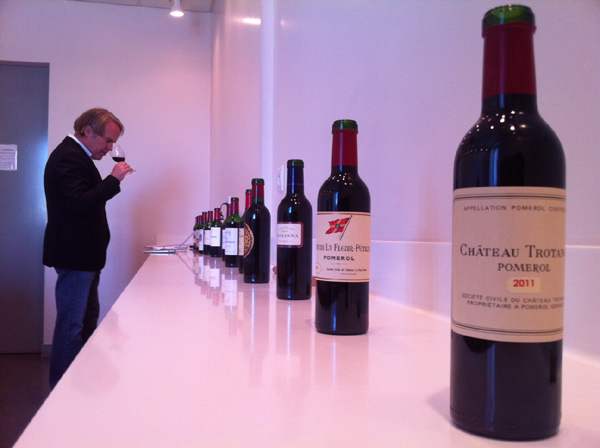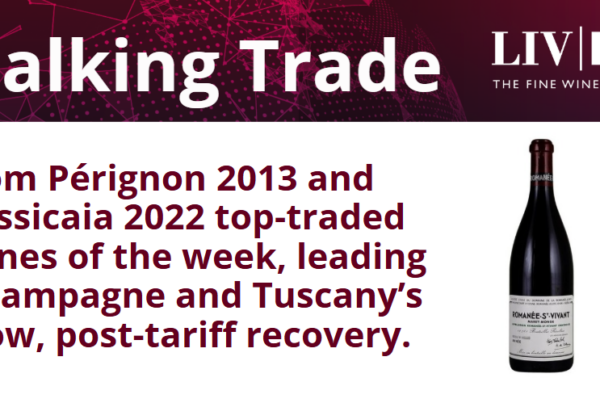James Suckling was in London last week and set aside some time to speak to us. The first part of our interview with him is shown below and focuses on the 2011 vintage and his experiences of tasting En Primeur. In part two, which will be published early next week, James discusses his favourite regions, his departure from the Wine Spectator and his relationship with Robert Parker.
You recently returned from Bordeaux, where you tasted the 2011 vintage. What were your overall impressions?
It is a very good to excellent vintage. The top estates, through their viticultural and winemaking expertise, can make excellent wines in challenging vintages nowadays. 2011 was difficult due to the growing season: the spring was very hot and dry, the summer was quite cool and not that sunny, and then you had an Indian summer. Some areas were affected by hail in early September and then you had an onslaught of botrytis as well. But the Bordelais are the best viticulturalists in the world and they know how to handle these difficult decisions. In the end, the top estates, and even some smaller estates, made some very good wines.
What are the defining characteristics of the vintage?
Denis Durantou of Eglise Clinet explained it to me best. If you look at it analytically, the wines tend to have the same amount of tannin as in 2010 and the same acidity level, but with around one degree less alcohol. So what you have are skinny, lanky wines that are not that big and voluptuous. I suppose you could describe them as slightly emaciated models.
What is good about the vintage?
The vintage harks back to the classic style of Bordeaux. It has a slight austerity and firmness with a nice perfume.
I have been tasting from barrel since 1982 and I was recently trying to remember what the wines remind me of. Perhaps 1986, with which it shares a tannic structure, although there aren’t the same highlights in 2011 that we saw in 1986, such as Mouton or Las Cases. Or maybe even 1975, but more modern, with riper tannins. Qualitatively, I think we are at the same level as 2004 (which I feel is underrated) or 2001. But stylistically, I would have to say 1986 or 1975.
I would say it is better than 1996, which is overrated apart from the very top Medoc wines, and it is better than 2008, which has a really high acidity that I don’t get on with.
Which wines and regions excelled?
Those producers that worked on picking the best possible grapes and then didn’t work them too much, with shorter macerations and lower extraction of tannin, tended to excel. Argilo-calcaire [clay and limestone] soils were also an advantage as they retained the moisture better during the drought. I also tended to like the wines high in Cabernet Franc, such as VCC, Ausone, Figeac and Cheval Blanc. Overall, I think the vintage has favoured the Right Bank.
Over on the Left Bank, Latour was fantastic, one of the wines of the vintage, along with Palmer and Mouton. And one that people should really consider is Pichon Lalande. It reminds me of their wines from the 1980s, such as the 1983 or 1986. Since Roederer bought it, Pichon has really got back to its best. They’ve cut out some of the Petit Verdot in the blend and that has really helped.
And don’t forget the whites. They are phenomenal and will be up there with classic years such as 2007, 2004 1997 and 1995 – really great with lovely richness and super-lively acidity. The Sauternes are also excellent.
What didn’t you like?
St Estephe was disappointing as many producers were forced to pick early due to the hail. The wines tend to be a bit lean and hollow. And from Margaux I found a lot of skinny and short wines, although Rauzan Segla was good and Palmer was amazing – one of the wines of the vintage.
What was the mood in Bordeaux, particularly around pricing?
Everyone from wine merchants to chateau owners, negociants and courtiers agreed that prices must come down enough to give people the incentive to buy these wines. But I’ve been doing this for 30 years and I’ve heard the same thing for 30 years. The only time they came down in a proper way was for the 2008s, when everyone thought we were in economic Armageddon and had no choice but to slash prices. This time I’m a little bit concerned. I know the top wine producers have very good intentions, but unfortunately it doesn’t always come out in the right way.
The wines need to come out below the price of the least expensive wine on the market. It’s going to be really hard for the very top estates to do that. The First Growths need to be under €300 per bottle and the Seconds at round €80, depending on the chateau. That’s a tough bullet to bite for some producers. But I hope that they do it – they’ve made a lot of money in recent years and now it’s time to provide some incentives to true lovers of Bordeaux. This is a vintage for those that love drinking claret; I don’t think it will be an investment vintage at all.
What do you look for when tasting out of barrel? Is it difficult?
The key thing to remember is that the nose isn’t important at all. I learnt that from Daniel Lawton, one of the great negociants of Bordeaux. The important thing is the texture – the quality of the tannins and how they relate to the acidity and alcohol – and then the finish. Wines with long seamless finishes are really the great wines. It’s not all about power.
It takes a long time before you can taste En Primeur properly. There’s a hierarchy in Bordeaux that helps as you can kind of figure out what should taste good. But to really understand how wines evolve you need a good 10 years of tasting. Bordeaux gets around 4,000 people arriving to taste EP each year, but I’m not sure how many of them really know how to taste properly. It’s not as easy as it seems and it’s a hell of a job.
There are always some doubts over the validity of tasting samples and whether they really represent the finished wine. What’s your opinion?
I find that, in general, they don’t play around with samples too much. If they do it becomes apparent afterwards when the wines are in bottle. What’s really important is the quality of the sample: how fresh it is, the temperature, and how much sulphur they have used. All of those things will change your interpretation. A warmer sample will appear softer and rounder and the alcohol will be more apparent. You also have to consider the air pressure on that day. A high-pressure day tends to show samples better than a low-pressure day.
I tend to like colder samples fresh from the barrel. A couple of times this year I said to the winemaker that I wasn’t very keen on the sample and asked to go into the cellar to taste the wine and all the various components.
When you taste at En Primeur you are just taking a photograph. And just like a good photo, a tasting needs to be properly thought out.
Another issue that keeps being discussed is the time of tasting. Famously, you tend to taste and report earlier than others. What’s your take on that?
I don’t really understand what the issue is. I’ve been tasting for 30 years at the same time [in March] and if other people want to taste early they should do it. A week or two doesn’t really have an impact on the wine and the chateau owners are happy about me coming when I do, so why not? Some of the big tastings during En Primeur week are what the Brits would call a “bun fight”. That’s not the proper way to taste wines. I like to taste calmly and spend time with people. It takes me two weeks to get through all of the wines. A lot of people taste 200 wines in four days. I don’t think it’s possible to do that properly.
Are there any favourite areas that you particularly like tasting in?
I love going to Pomerol. It’s like being in Burgundy, but with the producers paying more attention to detail. I think the wines are just fascinating. You can stand in the vineyards of VCC and you can see Petrus and Conseillante right next door, but they all have their own distinct styles.
You would think that after doing this for so long that I would be pretty jaded, but as soon as I go there, speak to the winemakers and taste some of the wines, I realise why I love this job.
What are your favourite Bordeaux back vintages and how would you rank them?
If I put recent vintages in order of preference then I would start with 2009, followed by 2010, 2005, 1989, 2000 and then 1982. I love drinking the 1982s, but there is such bottle variation and the yields were double what they are now. I remember asking Christian Moueix back in the early ‘80s what he thought of 1982 and he said, “We would have had another 1945 on our hands if the yields had been lower.”
But 2009 really is the vintage of our generation. I have absolutely no doubts. I tasted a number on my recent trip and they are just so beautiful. But from an investment perspective, I wouldn’t go near it. I think prices might go down when the euphoria from my high scores and Robert Parker’s high scores has died down.
And 1990? That seems to be missing from your list.
For me, the 1990s come just after the 1982s. There are some beautiful wines from the vintage, but I think the 1989s are going to be greater wines in the long run as they are that little bit more structured. There are some exceptions, like 1990 Latour, which is just incredible. Also, a lot of the 1990s have a problem with Brettanomyces because they didn’t use enough sulphur during the elevage. Although, you still have to say that they are great wines.
If a friend asked which back vintages to buy, where would you steer them?
I would buy Right Bank and Pessac Leognan wines from 1998 and 2001. They are both great, underrated vintages that provide good value, particularly if you stay clear of the Left Bank. I also like 2004, across the board. I have been buying and drinking a lot of wines from these vintages and they are drinking fantastically at great prices.
Check back on Monday to find out more about James’ departure from the Wine Spectator, his path to wine journalism and his relationship with Robert Parker.




